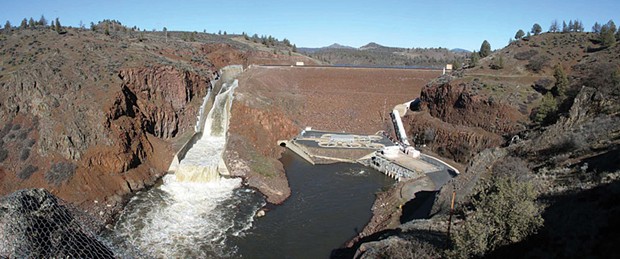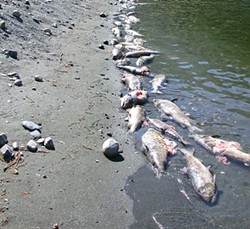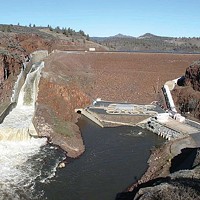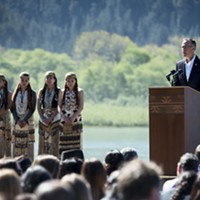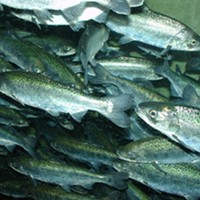Uncharted Waters
The demise of the Klamath Basin Restoration Agreement fosters hope, fear and anger
By Thadeus Greenson [email protected] @ThadeusGreenson[
{
"name": "Top Stories Video Pair",
"insertPoint": "7",
"component": "17087298",
"parentWrapperClass": "fdn-ads-inline-content-block",
"requiredCountToDisplay": "1"
}
]
The Klamath River watershed means many things to many people. That's a big part of the problem.
To the native tribes near the river's mouth, it means culture and survival, its waters having provided fishing grounds for salmon and steelhead that have sustained tribal members for countless generations. For farmers surrounding Upper Klamath Lake, near the river's headwaters in southwestern Oregon, its waters irrigate the farmland that's been in their families since the federal government gifted the land to their ancestors to thank them for their military service during the first and second world wars. Like the farmers, irrigators depend on the water flowing from the Klamath, as well as the affordable electricity that four dams currently clogging the Klamath River help provide. For ranchers in the area, the river water is necessary to raise the cattle that feed their families and support their communities. To PacifiCorp, the power company that owns the dams, the river provides electricity for its customers and profit for its shareholders.
For environmentalists, the Klamath River stands as both a cautionary tale and a source of great hope. It's sick — its flows dwindling during dry summer months with warm water pooling behind its dams and frequent outbreaks of toxic algae. Salmon runs have plummeted to an estimated 10 percent of what they once were, and almost annually biologists sound the alarm that disease and parasites are infecting the young salmon that do return. But in contrast to other rivers on the west coast, environmentalists see the 255-mile Klamath as a river that can be saved, one that — unlike the San Joaquin — isn't too far gone.
And to some conservatives, the Klamath River represents the proverbial first domino in the national dam-removal debate, as it would constitute the largest such project in United States history and arguably one of the largest river restoration efforts in the world. To some, dams symbolize the harnessing of the wild for the good of mankind. If the Klamath dams are removed and the river is restored, they fear a precedent will be set and other rivers will be turned free as fish are prioritized over people.
This is the complicated fabric from which the Klamath agreements — a set of three pacts forged by stakeholders in the watershed — were born. It's the web that ensnares every debate about the landmark agreements, and it encompasses all the lenses through which people saw last month's news that the agreements' centerpiece — the Klamath Basin Restoration Agreement (KBRA) — had expired, with Congress having failed to pass legislation to enact it before the Dec. 31 deadline.
This fabric will also frame all future negotiations, lawsuits, settlements and agreements on the river's future. As the Journal goes to press, what's next for the Klamath River and all who depend on it remains unclear. What is clear, however, is that while the KBRA is likely dead, the desire of many to see the Klamath's waters running freely once again is not.
Decades of conflict along the Klamath River came to a head in the drought-plagued fall of 2001, after a federal judge ruled the shortnose sucker — a bottomdwelling fish that lives to be more than 30 years old — in Upper Klamath Lake required protection under the Endangered Species Act. The Department of the Interior responded by shutting off water supplies to some 1,400 farmers that September, leaving crops to whither and some farmers on the brink of bankruptcy.
The following year, with dealing by then Vice President Dick Cheney, the federal government made sure the farmers and irrigators around Upper Klamath Lake got their water. The results were disastrous, as flows in the Klamath River dwindled, water temperatures rose and gill rot spread among thousands of chinook salmon returning to spawn. An apocalyptic scene followed, with more than 50,000 dead salmon rotting in the once pristine river's waters.
The summers of 2000 and 2001 brought the Klamath water wars to a head, but they were the culmination of decades of problems with one central theme: The federal government had made more promises than it could keep.
In order to lure farmers to the area in the early 1900s to grow the crops needed to fuel a western population boom, the federal government gave out homesteads around Upper Klamath Lake, promising water to irrigate fields. A few decades later, the government doubled down, giving away thousand-plus-acre plots in a lottery to war veterans as a show of gratitude. And as more and more of the wetlands, lakes and marshes surrounding Upper Klamath Lake were converted to farmland, the federal government created hundreds of thousands of acres of national wildlife refuges around the basin to support the hundreds of species of native birds, ducks and geese. The refuges are also dependent on water pumped in from the Klamath.
Coupled with the Endangered Species Act and a Department of the Interior determination in 1993 that the Yurok and Hoopa Valley tribes have "the right to harvest quantities of fish on their reservation sufficient to support a moderate standard of living," drought years drove home the fact that there wasn't — and isn't — enough water for the government to make good on its promises.
And the hostilities that came with these hollow promises only rose through the 1990s and into 2001, with tribes, fishermen and environmentalists viewing the diversion of water to farms and ranches in the Upper Klamath as a kind of theft, yet another violation of trust to transfer wealth at the expense of the North Coast's environment, species and people.
Craig Tucker, now the Karuk Tribe's natural resources policy advocate, was working for the Sacramento-based nonprofit Friends of the River at the time of the fish kill in 2001. "The Klamath has it all," Tucker said. "Anyone interested in social justice and the environment — the Klamath is it."
The removal of PacifiCorp's four dams on the lower Klamath — Iron Gate, Copco 1, Copco 2 and John C. Boyle — became the goal and Tucker said one of his colleagues came up with a corporate accountability campaign against the utility company, which was then owned by Scottish Power, a multinational corporation with an environmentally friendly reputation. While Tucker said the idea gained little traction with environmental groups at the time, local tribes quickly got on board.
In 2004, a local coalition traveled to Scotland to crash the company's shareholders' meetings. With the help of a Scottish public relations firm, local newscasts and papers ran stories of tribal members from Northern California descending on Scotland to cook salmon and decry the dammed Klamath River, noting that while all dams in Scotland at the time were required to have fish ladders, the Klamath dams had none. "The trip was so successful that the Scottish Green Party introduced a bill to strip [the company] of their name because they didn't want to be associated with a company that would deprive native people of their food source," Tucker recalled, adding that a separate contingent also traveled to London to meet with green mutual fund managers and explain why Scottish Power shouldn't be part of an environmentally conscious investment fund.
The campaign proved successful and, within a year, Scottish Power had washed its hands of PacifiCorp, selling it off to Berkshire Hathaway, a multinational conglomerate lead by Warren Buffett, who Forbes ranked as the third-wealthiest person in the world last year.
Back on the Klamath, the water war was in full swing, with lawsuits over water rights flying from all corners in all directions. It was around 2004, when Troy Fletcher, the longtime executive director of the Yurok Tribe who died of a heart attack in November, traveled upriver to meet with irrigators and farmers.
"At the end of the day, it was apparent to me and I think it becomes apparent to others, that the federal government, the United States Congress, the administration, they're not going to be able to solve our problems for us," Fletcher said in an interview for the documentary film A River Between Us. "We're going to have to solve the problems they created."
Tucker, who had gone to work full time for the Karuk and Yurok tribes in 2004, said the timing of Fletcher's trip was aided by PacifiCorp's recent rate hikes — as much as 1,000 percent in some cases — creating a hardship for farmers in the Upper Klamath basin. Fletcher's message to irrigators was simple, according to Tucker: "Let's call a truce and stop trashing each other in the press. This is really about a multi-national energy giant versus rural communities."
With that, a years-long negotiation began between tribes, irrigators and farmers. At the center were Fletcher and Greg Addington, then executive director of the Klamath Water Users Association, a group of irrigators working the old wetlands and lakes the federal government turned into farmlands under the Klamath Project of the early 1900s. "It was, frankly, a brutally hard undertaking," Addington said over the phone recently.
The hardest part, according to those at the table, was getting everyone to leave behind feelings of what they were owed or entitled to and to see the issue through the eyes of their historic adversaries. Generations-old grudges had to be checked at the door. But through the meetings — and the conversations over burgers and beer that often followed — the parties started realizing they had more in common than they'd thought or cared to admit. And all began to see what was at stake for their counterparts: their way of life, culture, heritage and survival. They began to try to forge a compromise aimed at respecting and preserving all involved.
Meanwhile, Tucker and others continued an aggressive public relations campaign against PacifiCorp's owners, even protesting at 2009 Berkshire Hathaway shareholders' meetings and parties in Omaha, Nebraska, Buffetts' hometown. Tucker recalled one evening when about 15 tribal members staged a die-in at a lavish cocktail party in a large, upscale jewelry store. Clad in full regalia, the tribal members keeled over and pretended to die on the steps as fellow protesters put up police tape and chalked off their bodies. National Geographic and Associated Press reporters documented the scene as shareholders in black-tie attire awkwardly side stepped the morbid scene.
By the time tribes, environmentalists and irrigators reached an accord in 2009, PacifiCorp was ready to come to the negotiating table and, the following year, agreed to a dam removal deal.
Signed in 2010, the initial Klamath agreements consisted of two separate deals: the Klamath Basin Restoration Agreement and the Klamath Hydroelectric Settlement Agreement. Together, the agreements would see PacifiCorp OK the removal of its four dams as long as ratepayers and the states of California and Oregon picked up the tab for removal and the federal government indemnified the company from any liability associated with pulling the dams. Klamath Basin irrigators got some measure of water security and an assurance that valves wouldn't be shut off in drought years in exchange for reducing their water diversions. And the Yurok and Karuk tribes would see the dams removed, increased storage in Upper Klamath Lake and flows into the river, as well as more than $400 million federal spending on fisheries restoration, reintroduction and monitoring over a 15-year-period in exchange for continuing to allow farmers to divert water for agriculture.
It seems nearly all 45 parties to the initial agreements gave up something in the compromise — Tucker said the Karuk Tribe, "in a perfect world, would get all the water." Others walked away from the table. Some ranchers around Upper Klamath Lake believed they were being asked to sacrifice too much and that a federal court would soon grant them senior water rights well beyond anything they'd receive through the pact. The Hoopa Valley Tribe, which had been a party throughout the negotiations, decided not to sign the deals, fearing they didn't guarantee enough water for fish. The tribe would later argue that the agreements' proceeding without them sacrificed their rights to fish that travel up the Klamath and into the Trinity.
Criticism of the deals extended beyond the potential parties as well. Some environmental groups charged they didn't do enough to protect fish and constituted a sweetheart deal for PacifiCorp, while a host of other groups lambasted the deals' hefty price tag.
As the initial parties lobbied Congress to enact the agreements, negotiations continued. In March of 2013, the state of Oregon officially recognized the Klamath Tribes as the most senior water-rights holder in the Upper Klamath Basin, leaving the area's ranchers in a precarious position that pushed them back to the negotiating table and paved the way for the Upper Klamath Basin Comprehensive Agreement of 2014, the last of the three Klamath pacts.
The upper basin agreement saw the Klamath Tribes cede some of their senior water rights to allow the irrigation of 18,000 acres of farmland in exchange for increased flows into Upper Klamath Lake. The tribes also get $45 million in federal economic development funds and federal help acquiring the Mazama Forest, a long-sought after 90,000-acre piece of land that used to be part of the tribe's reservation.
Tucker, who'd spent the years after the initial Klamath agreements were signed in 2010 lobbying Congress to enact them, saw the upper Klamath basin deal as a huge step, one that brought cattle ranchers into the fold and won the Oregon Cattlemen's Association and Oregon Farm Bureau's endorsements of the Klamath agreements. The new deal, Tucker thought, promised to deliver the support of Oregon Congressman Greg Walden, the state's only representative who'd yet to fully embrace the agreements.
"My political calculus was, once you line up all these groups, how does Walden still say no?" Tucker said.
If you want to understand why the Klamath deals never received congressional approval, proponents say you have to understand that timing is everything.
The initial deals were signed in February of 2010. Nine months later, the Democratic party took a beating in the midterm elections, losing control of the House and ceding ground in the Senate in what's been described as the largest political swing Congress has seen since the Great Depression. The elections heralded a new political force in the country — the Tea Party — which, combined with the subprime mortgage crisis and the near collapse of the financial industry, put a renewed focus on fiscal conservatism.
It was suddenly a very bad time to ask Congress to allocate hundreds of millions of dollars in spending, and an even worse time to ask Congress to allocate hundreds of millions of dollars in spending for what could be billed as the single largest environmental restoration project in the nation's history. The country was entering a period of bitter partisanship that would paralyze Congress.
If you talk to those close to the Klamath agreements, they'll focus much of their political ire at two people: Walden, the Oregon congressman, and Alaska Sen. Lisa Murkowski. As chair of the Senate Committee on Energy and Natural Resources, Murkowski tabled a bill introduced by Oregon's Senate delegation in 2014 and 2015, making sure it never got a hearing. Mike Orcutt, the fisheries department director for the Hoopa Valley Tribe, said Murkowski's opposition to the agreements stems from her believing, as the tribe does, that the deals strip the Hoopa Valley Tribe of its fishing and water rights without its consent. Even if that's true, it seems unlikely the agreements would have had much traction with Murkowski anyway, as the senator has supported oil drilling efforts in the Arctic National Wildlife Refuge, a measure that would have blocked the Environmental Protection Agency from limiting the greenhouse gas emissions of major industries and a bill that would have raised the liability cap for oil spills from $75 million to $10 billion. In short, her record of voting with the environment isn't great.
Klamath proponents have long considered Walden their best bet for action in Congress, as the agreements were forged in the heart of his district and have the support of swaths of his constituents. Additionally, Walden, who was first elected to Congress in 1999, is now the House's third highest ranking member as the chair of the National Republican Congressional Committee, a committee that essentially exists to funnel money and support to Republican candidates and causes. If Walden wants to get something done, most feel he has the pull.
As recently as October, it seemed Walden was preparing to push for the Klamath agreements, even if reluctantly. "Personallly, I'm not a dam removal support guy," he told the Herald and News on Oct. 15. "But the facts that have been agreed to [in the pact] require [dam removal] and there are really no alternatives unless you want to blow the whole agreement apart and give up on water certainty for agriculture and all the other components that go with the agreement."
Eight days after Walden gave that interview it was announced that he would face the first major primary challenge of his congressional career, from none other than Oregon Tea Party favorite Dennis Linthicum, county chairman of Klamath County, which opted out of the Klamath agreements in 2013 after a change in leadership. Walden didn't say much more about the Klamath agreements publicly until December, when — about two weeks before the close of the congressional session — he released a Klamath draft bill for review. The draft didn't include dam removal and approved the giveaway of a 100,000 acres of U.S. Forest Service land to both Siskiyou and Klamath counties. (Siskiyou County never supported the agreements.) A political nonstarter, Walden's draft bill was never introduced.
North Coast Congressman Jared Huffman said the draft bill was little more than political cover, something Walden could point to when talking to Klamath agreement supporters to say he tried. "I think he understood that he had some explaining to do about why absolutely nothing has happened in the House under his watch," Huffman said. "The discussion draft was much more of a veneer of activity than a genuine response to the issue."
Congress adjourned Dec. 18 without taking any action on the Klamath legislation. The parties convened a conference call 10 days later to begin terminating the Klamath Basin Restoration Agreement.
Walden did not respond to a Journal interview request.
The path forward is unclear, though hope for removal of the Klamath dams is far from lost. Huffman, for his part, said he's more energized on the issue than he has been in years because there's finally the opportunity for action and he no longer has to sit idle, waiting on his Republican colleagues.
The Hoopa Valley Tribe, never a party to the initial agreements, has been pursuing dam removal through the Federal Energy Regulatory Commission (FERC), which is tasked with renewing PacifiCorp's licenses to operate the dams, licenses that expired back in 2006 but have been held in abeyance pending the outcome of the Klamath agreements. The tribe's hope — now shared by the Yurok and Karuk tribes — is that by pushing forward with relicensing, it can force PacifiCorp to comply with clean water laws by installing fish ladders on all four dams, which would likely prove more expensive in the long run than removing the dams altogether.
In an interview with the Journal, PacifiCorp spokesman Bob Gravely indicated the company isn't necessarily opposed to removal of the hydroelectric dams. "It's a power plant that we use to provide electricity to customers and the license is expired," he said. "Dam removal for a lot of people means a lot of things, and for us, we just need an outcome for an expired federal license that's a good outcome for our customers in the eyes of our regulators. With the protections provided by the Klamath Hydroelectric Settlement Agreement, removing the dams and replacing the power was going to be a better way forward for our customers than relicensing with the new requirements that it would [include]."
And Gravely pointed out that the KHSA remains in effect, even though its counterpart Klamath Basin Restoration Agreement has expired. The $450 million for dam removal — $200 million from PacifiCorp rate payers and $250 million from a California water bond — also remains allocated for removing the four dams. "The question," Gravely said, "is how do we move forward in a way that's acceptable as far as cost and risk."
The liability waiver was crucial for PacifiCorp to sign onto the initial agreement, and Tucker said he and others are researching options, including whether a third party could purchase liability insurance for the dam removal process or an executive order could indemnify the company. One idea is to have PacifiCorp surrender its license through the FERC process to a joint trust that would initiate the decommissioning process. "The concept is certainly viable," said Gravely.
But while dam removal still seems an entirely viable outcome, there are things lost with the demise of the KBRA. From an environmental standpoint, the hundreds of millions of dollars in habitat restoration funds are a crucial setback. But the hardest hit by the agreements' apparent demise could be Walden's constituents — the ranchers and farmers of the Upper Klamath Basin who now face the prospect of an un-dammed river without any water or energy cost assurances.
"That's the irony, is that there are still plenty of mechanisms to push dam removal and river restoration, but the ones who may be left out in the cold here are Klamath irrigators who received some very serious water assurances under the agreement," Huffman said. "They could be the real losers here in the big picture and, ironically, they're the ones represented by Greg Walden."
Addington, with the Klamath Water Users Association, said the current situation — the prospect of dam removal without a water deal in place — was the "worst nightmare" scenario he envisioned a decade ago. Now, having forged relationships and friendships downriver, Addington said he understands the importance of dam removal to those communities. He doesn't know what his next step is. "Do we now have to oppose dam removal?" he asked. "We don't want to be in that situation, but we had things we really need. We need a water settlement with the tribes. We need help on the energy stuff. Those issues still exist for us. ... On the one hand, we have to pick up our lawyers and go marching back into the places we didn't want to be, and we're going to do that, but on the other hand, we want to keep looking at ways to settle these issues."
Tucker conceded that litigation over water issues looms heavy on the horizon: "We've still got the dam removal deal, but the water piece, we're going to be fighting over that for decades"
And time, it would appear, isn't on anyone's side. On the heels of several drought years, conditions on the Klamath are dire, according to biologists, and salmon populations have dwindled. Meanwhile, some hundreds of miles of historic spawning grounds remain blocked behind impassible dams and pools of water that stagnate and warm in the summer.
Where the communities along the Klamath River once had a map — if an imperfect one — to addressing their needs, they now find themselves in uncharted waters. And some appear to be on a collision course.
Comments (3)
Showing 1-3 of 3
more from the author
-
Seeking Salvation
'Living in amends,' a candidate for resentencing hopes for another chance
- Apr 18, 2024
-
UPDATE: Artillery Shell Deemed Safe in Ferndale
- Apr 12, 2024
-
Turning the Titanic
Cal Poly Humboldt recognized for leadership in addressing global plastics crisis
- Apr 11, 2024
- More »
Latest in News
Readers also liked…
-
Through Mark Larson's Lens
A local photographer's favorite images of 2022 in Humboldt
- Jan 5, 2023
-
'To Celebrate Our Sovereignty'
Yurok Tribe to host gathering honoring 'ultimate river warrior' on the anniversary of the U.S. Supreme Court ruling that changed everything
- Jun 8, 2023
